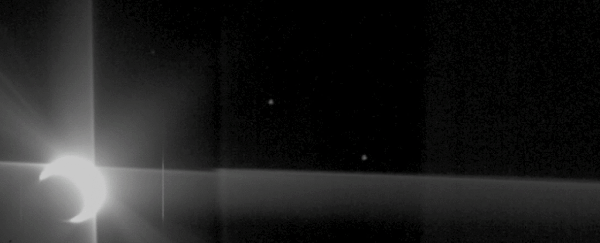Venus may be a poisonous nightmare planet where habitability is concerned, but is there any other planet in the Solar System that shines so brightly?
Actually, the answer is an unequivocal "no". Venus is the most reflective planet in the system, which is why it gleams so brilliantly as the (not-quite-correctly-named) evening star. And a recent flyby from ESA and NASA's Solar Orbiter is a gorgeous demonstration of this.
On 9 August, the probe passed within 7,995 kilometers (4,967 miles) of the surface of Venus as it performed the second of its eight gravity assist maneuvers to help it gain speed and trajectory boosts from the planet's gravity well as it orbits the Sun.
During this time, Solar Orbiter's Heliospheric Imager instrument was trained on the planet, to see if it could pick up anything interesting. This is not without precedent: NASA's Parker Solar Probe and the ESA's Mercury probe BepiColombo have also taken a close squiz at Venus during gravity assist flybys.

Between reports of recent volcanic activity and weird molecules in the atmosphere, the planet is looking increasingly interesting, yet only one probe is currently active, Japan's Akatsuki. Thus, flybys provide an opportunity to gather additional data with different suites of instruments.
This approach has given us some really interesting information. Parker, for instance, detected surface features through Venus's thick cloud layer; no one was expecting it to be able to, but the fact that it could opens up some new observation possibilities.
On another flyby, Parker detected radio emissions from Venus - the first such recordings in three decades, allowing new insight into how the Sun's cycles affect the planet's atmosphere.
So you can see why the Solar Orbiter team was geared up to take some readings as the probe swung around the darkened nightside of Venus. Sadly, it was not to be. The planet is just way, way too shiny, reflecting roughly 75 percent of the sunlight that hits it.

You can see how this turns Venus into a white, featureless ball in the above video taken by the BepiColombo probe just a day later, as it performed a gravity assist maneuver of its own on 10 August.
"Ideally, we would have been able to resolve some features on the nightside of the planet, but there was just too much signal from the dayside," said astrophysicist Phillip Hess of the Naval Research Laboratory of the Solar Orbiter images.
"Only a sliver of the dayside appears in the images, but it reflects enough sunlight to cause the bright crescent and the diffracted rays that seem to come from the surface."
Ba-baaooooow.
Nevertheless, it makes for an absolutely stunning video, with the gleaming crescent Venus slipping past the probe, and the Taurus constellation stars Xi Tauri and Omicron Tauri in the background.
Solar Orbiter will be performing six more Venus gravity assists in the coming months and years. Maybe one of those will be able to capture more information, while we wait for NASA's two upcoming missions to the mesmerizing alien world.
